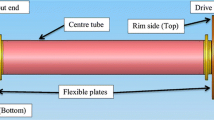Abstract
The high speed flexible coupling (HSFC) is used on the fighter aircraft gas turbine engines utilizing non-lubricated, metallic flexible plates. The HSFC has to transmit power at high speeds typically ranging from 10,000 to 18,000 rpm from engine gear box to accessory gear box. The HSFC also accommodates large axial and lateral misalignments due to thermal expansion and flight dynamics. The imposed angular and axial displacement distorts or bends the flexible plates. To achieve an infinite life design for HSFC, it is necessary to keep away from the different natural frequencies from the operating range of speeds apart from the optimal structural strength to accommodate larger misalignment. This paper discusses about details of system analysis, design and evaluation of HSFC for gas turbine engines. The dynamic characteristics of the HSFC are investigated through the finite element analysis (FEA) and experimental verification. The present approach can be extended for the development of similar type of flexible couplings.
Similar content being viewed by others
References
Wyckaert, Katrien, G. McAvoy and Peter Mas, Flexible substructuring coupling based on mixed finite element and experimental models: A Step Ahead of Transfer Path Analysis, Proc. of — SPIE, The International Society for optical Engineering (1996) 633–640.
Sinou, J-J. Cristiano Villa and Fabrice Houverez, Experimental and numerical investigations of a flexible rotor on flexible bearing supports, International Journal of Rotating Machinery, 3 (2005) 179–189.
S. W. Doebling, C. R. Farrar and M. B. Prime, A summary review of vibration based damage identification method, Shock and vibration digest 30, 2 (1998) 91–105.
S. S. Kessler, Certifying a structural health monitoring system: Characterizing durability, reliability and longevity, Proc. of the 1 st International Forum on Integrated Systems Health Engineering and Management in Aerospace, Napa, CA (2005) 7–10.
C.-Y. Tsai and S.-C. Huang, Transfer matrix for rotor coupler with parallel misalignment, Journal of mechanical science and technology, 23 (5) (2009) 1383–1395.
S. Nagesh, Ganesan. S and Chandrasekaran. C, Design and development of power take off shaft with contoured diaphragms for aircraft application, Proc.of DRDO work shop on advanced manufacturing, DRDL Hyderabad (2004) 784–794.
Aerospace Material Specification, AMS 4928Q Titanium Alloy Bars, Wire, Forgings, Rings, and Drawn Shapes 6Al — 4V Annealed, Society of Automotive Engineers Inc. (2001).
Robert D. Cook, Finite element modeling for stress analysis, John Wiley & Sons Inc, NY (1995).
S. S. Rao, The finite element method in engineering, Second Ed, Pergamon Press, Oxford (1989).
MIL STD 810G, Test method standard for environmental engineering considerations and laboratory test, US Army Developmental Test Command (2000).
Author information
Authors and Affiliations
Corresponding author
Additional information
Recommended by Editor Yeon June Kang
Nagesh, S. received his post graduate degree in Mechanical Engineering Design from PSG College of Technology, Coimbatore, India. He is working as scientist in Combat Vehicles Research and Development Establishment, Chennai, India for the development of high speed flexible coupling for aircraft applications. His fields of interest are Rotor dynamics and Active Vibration Control system.
Junaid Basha, A. M, received his Ph.D. from IIT Madras, working as scientist in Combat Vehicles Research and Development Establishment, chennai India. He is leading a research group for the devlopment of Hydraulic filters for aircraft aplication and Portable Ultra fine filter system for Hemodialysis of human. His present research interests focus on high speed rotor system.
Thakur Dinesh Singh, received his Ph.D. from IIT Madras working as Associate Professor in Defence Institute of Advanced Technology, Pune, India. His area of research includes Rotor dynamics, High speed machining of aerospace materials, Precision Engineering.
Rights and permissions
About this article
Cite this article
Nagesh, S., Junaid Basha, A.M. & Singh, T.D. Dynamic performance analysis of high speed flexible coupling of gas turbine engine transmission system. J Mech Sci Technol 29, 173–179 (2015). https://doi.org/10.1007/s12206-014-1224-x
Received:
Revised:
Accepted:
Published:
Issue Date:
DOI: https://doi.org/10.1007/s12206-014-1224-x




